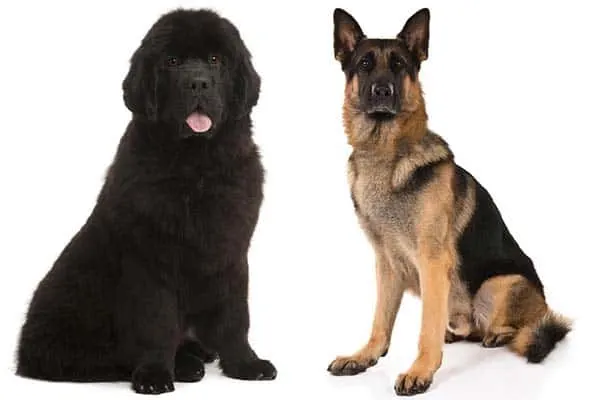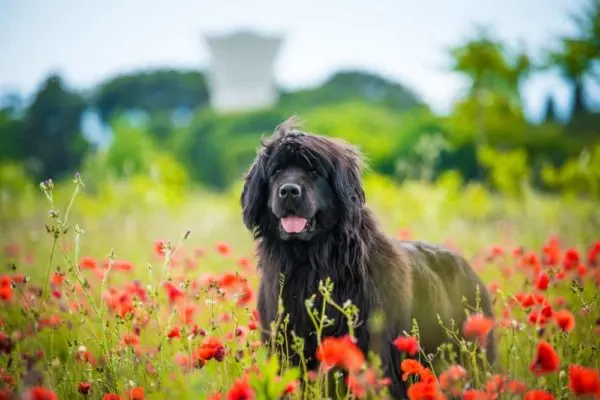Newfoundland German Shepherd Mix: How to Fit a New Shep In Your Life
One of the most pressing questions you might ask yourself is why do we intentionally mix dog breeds. After generations of perfecting a particular breed, why would we now want to add diverse genetics to dogs like the German Shepherd?
If you walked into a shelter today, you might guess 30 to 50% of them had German Shepherd ancestry, and you could very well be right.
The German Shepherd Newfoundland mix is no accident. Also called a ‘New Shep’ & the ‘Newfie Shepherd’, it is a designer dog, specifically bred for desirable qualities of two different parents.
Since breeders intentionally seek to produce German Shepherd-Newfoundland hybrids, their characteristics are more predictable than other mixes.
Let’s dig into the features that New Sheps potentially inherit from their parent breeds, and what distinguishes this hybrid.

German Shepherd Newfoundland Mix: How did we get the New Shepherd?
No one knows for sure who first came up with the idea to breed a German Shepherd with a Newfoundland or exactly why. Experimentation with the breeding probably occurred a few times before anyone came up with a clear-cut reason or thought it was a good idea.
We know the German Shepherd originated in Germany from generic herding dogs. A show dog named Hektor became the foundation type for the breed, further developed by Max von Stephanitz beginning in the late 1890s.
According to German Shepherd Rescue Elite, Stephanitz was a former student of Berlin Veterinary College and highly interested in how conformation correlated with working proficiency. The German Shepherd joined the AKC in 1908.
The Newfoundland’s history is not quite as clear-cut as the GSD’s. Most experts agree that Newfoundland originated from native dogs of the Newfoundland coast and Labrador, in Canada, but are uncertain if the black wolf, Great Pyrenees, or others had the greatest influence.
DNA confirms the fact that St. John’s Dog gave rise to both the Newfoundland and Labrador Retriever, with mastiff breeds introduced into the Newfie bloodlines around the late 1500s or early 1600s. A well-established Newfie type was apparent by 1610, represented by massive black dogs that had huge heads.
George Cartwright officially named the Newfoundland in 1775, and the English further modernized the breed beginning in the 1800s. The Newfie joined the AKC in 1886 and the English Kennel Club in 1903.
What is a designer dog?
Undoubtedly clear to most, not every mixed dog is a designer dog. The marketing of specific breed combinations enables owners of these hybrids to ironically attain an elevated social status among their peers.
In historical times, starting with the Victorian era in the 1900s, many societies linked superiority with smaller genetic pools. Owning a purebred dog was equivalent to privilege.
Until the advent of what would become the designer dog craze, purebred dogs remained at the pinnacle of desirability and personal worth in many societies.
The appeal of certain purebred dogs, like French Bulldogs and Pugs, will probably never wane, but designer dogs have given owners another avenue to climb the social ladder. Generally, the name of the hybrid will be a blend of the two separate breed names.
The Labradoodle was the first such designer dog, matching a Labrador Retriever with a Poodle in 1989, and the New Shep arrived much later. The New Shep remains much less common than some of the other designer dogs.
Many early designer dogs originated intending to introduce the hypoallergenic low-shedding hair of the Poodle to breeds with desirable charms like an easy-going steadfast temperament, unusual charisma, or unique coat color.
Later, dog lovers sought to improve the health issues of breeds they loved such as the English Bulldog.
According to the results of the Dalmatian/Pointer backcross experiment published by vin.com and others, the elimination of major health issues can occur with hybridization, but it may require several generations.
Purely speculative, the New Shep may have come about to smooth some aggressive and neurotic tendencies of the Shepherd and increase the lifespan and add novelty colors and trainability to the Newfie.

What makes the New Shep unpredictable?
New Shep puppies have a greater number of standard characteristics in common with each other than alternative German Shepherd crosses because there are more of them.
We can judge probability based on how the majority of current litters turn out. That being said, first-generation genetics is still largely a roll of the dice.
Many features, like personality and temperament, are more unpredictable than coat length and size. Individuals inherit some qualities as a straightforward recessive or dominant single gene. For example, 75% of your puppies may inherit the same upright ears. Other genes, like those for coat color, are multiple and incompletely dominant.
Separate breed standards tell the tale of the Newfie Shepherd Mix.
Most people know what a purebred German Shepherd or Newfoundland looks like.
The German Shepherd, with her elegant good looks, has a dome-shaped forehead with a narrow, somewhat square muzzle, a long back sloping down from the shoulders to the hips, brown slightly-slanted eyes, large open upright ears, and a thick tail.
Classic colors are tan or red with a black saddle and black mask. German Shepherds can also be silver and black, sable, or solid colors like red, blue, black, or white.
Where Shepherds are solidly-built and athletic, Newfoundlands are stately and powerful. They also have a dome-shaped forehead but it is larger and broader than a GSD’s with a shorter and wider muzzle.
They average about 150 pounds in weight and stand 26 to 28 inches tall at the shoulders, compared to the German Shepherd’s 24 to 26 inches and 50 to 100 pounds.
A Newfie’s eyes are brown, rounder than a Shepherd’s, and their ears fold forward at the base, hanging close to the head and reaching to the upper lips. One of their most remarkable features is their partially webbed feet, which contribute to their legendary swimming ability.
Newfoundlands can sport the colors solid black, brown, white and black, known as Landseer, and, less commonly, gray.
New Sheps range from 23 to 28 inches tall and average 180 to 190 pounds. The range, however, can be from 100 to over 200 pounds. A female’s height is at the shorter end of the spectrum and, according to Doggiedesigner.com, she will weigh 3 to 5% less than a male.
New Shep dogs sport an array of colors such as black and tan, solid black, gray, silver, blue, or red, black and white, or sable.
What is hybrid vigor?
Hybrid vigor, despite numerous misconceptions, does not necessarily imply increased health and vitality. It refers, however, to improved biological functions which usually influence size and fertility.
According to the Centre for Small Animal Studies in Suffolk, hybrids tend to have a higher lifespan than purebred dogs except for certain toy breeds. Moreover, any comparison between dogs illustrates a smaller size generally means a longer life.
Not all crossbreeding results in hybrid vigor.
New Sheps are frequently larger than their parents. It is not uncommon to see Shepherd Newfoundland mixes that are 200 pounds. At the same time, the hybrid’s lifespan is about 10 years, slightly longer than the purebred Newfoundland’s but shorter than the German Shepherd’s. Giant size likely accounts for a shortened longevity.

What kind of personality can you expect?
A German Shepherd’s intense personality that allows him to focus single-mindedly on his duties makes him an ideal working dog but unsuitable for some households.
German Shepherds are also courageous, loyal, affectionate with their families, and protective. Poor breeding allows fearfulness, aggression, or neurotic tendencies to enter specific German Shepherd lines.
The breed standard for the Newfoundland calls for a sweet disposition to define her, more important than any other character trait. The Newfoundland’s loyalty, selflessness, and courage make her among the most prolific rescue dogs. An irresponsibly bred Newfie can be fearful or aggressive.
A German Shepherd Newfie cross should shine as a family companion with a loyal, sweet, and affectionate nature. Most puppies exhibit the calm and docile natures of the Newfoundland.
New Sheps tend to get along with children and other dogs, especially with effective socialization by you the owner. Shepherd-Newfoundland hybrids may inherit some dog aggression from the GSD and same-sex aggression from the Newfie. Again, frequent exposure to other dogs as a puppy will help prevent inter-dog aggression from cropping up later in life.
Does New Sheps have high intelligence and trainability?
According to Dogbreedslist.info, a ranking of dogs based on trainability and other criteria involved in canine intelligence, German Shepherds rank No. 3 and Newfoundlands are lumped No.34 with a group of other very smart dogs like Staffordshire Terriers, Gordon Setters, and Bearded Collies. The ranking includes 137 purebred dogs.
Both breeds are amenable to consistent and early training.
The German Shepherd excels at learning quickly and obediently. She is considered one of the most trainable dogs. The shepherd’s shortcomings in training include dominance and a tendency to become bored.
Newfoundlands demonstrate an uncanny instinct for the prevention of drowning and knowing how to save people from hazardous situations on land. However, they tend to be independent and need repetition to pick up simple commands.
How much exercise does a New Shep need?
If you have ever befriended a GSD, a New Shep will present a dramatic difference in activity level. Hybrids inherit the more laid-back demeanor of the Newfie, not nearly as exuberant as the Shepherd. They require moderate to low exercise.
Depending on size and coat, you need to restrict a New Shep’s activity during hot summer days as they have a low heat tolerance. The winter cold is not likely to be a concern for your New Shep. Newfoundland and Shepherd mixes are also sure to enjoy swimming.
Some training and walking services suggest 14 miles per week and an hour every day of exercise for your New Shep, although your dog will probably thrive on half that.
Grooming requirements depend on coat thickness
Both the Newfoundland and German Shepherd have thick undercoats. They have two large molts a year, dropping copious tufts of hair during these times.
The Newfoundland requires daily brushing to prevent matting of his fleecy down. The Newfoundland’s coat is usually longer and thicker than even the long-haired Shepherd’s. The rare Shepherd has long hair without an undercoat.
Both dogs should get a consistent bath to eliminate odors and resistant dirt. German Shepherds are not particularly averse to water, but most Newfoundlands love it.
New Sheps can possess a variety of coat types. Most of them will have a medium to long moderately thick wavy outer coat with dense underfur. Some have short hair and others have thinner hair than usual for either breed.
A few dogs have straight hair while others appear to have loose curls in areas. Brushing is crucial for the same reasons as with the parent breeds.
Will your New Shep be a good watchdog?
While the German Shepherd is renowned for guard abilities, the Newfoundland has always had a more utilitarian heritage.
Since biting and aggression is so contrary to rescuing people from the water, the Newfie has minimal guarding tendencies. You are pretty lucky if your Newfie barks to announce a stranger.
You can expect a Newfoundland German Shepherd mix to be friendly and even affectionate to guests. They likely will make better watchdogs than Newfies, barking if sensing a disturbance.
Certain families of dogs, as mentioned above, can produce New Sheps with the same undesirable characteristics of the responsible parent, such as fear-biting, uncharacteristic aggression, and shyness.
What are the New Shep’s health concerns?
Unfortunately, ailments plague all purebred dogs. While trying to improve a breed through hybridization is a noble endeavor, the reality often falls short. Improvement in the puppies is only possible when exercising a strict selection process with the parents.
Some breeders do not adhere to strict breeding criteria, whether involved with purebreds or designer dogs. Moreover, potential owners may not know what kinds of problems their new dog may be susceptible to or what tests may pertain to particular breeds. Still, another factor is dogs inherit some disorders like hip dysplasia, across multiple genes
While a few of the sources we ran across cited Shepherd Newfie hybrids as having no health issues, this is probably not entirely accurate.
Because of their parentage, we must theorize that New Sheps are vulnerable to the following health issues, discussed by Science Direct and PetMD.
- Hip and Elbow dysplasia – large frame and from GSD and Newfie
- The propensity for weight gain – Newfie
- Sub Aortic Stenosis (narrowing of space under the aortic valve of the heart, obstructing blood flow) – Newfie
- Hemophilia ( blood clotting disorder ) – GSD
- Epilepsy – lines of GSD and Newfie
- Von Willebrand’s (bleeding disorder) – Newfie
- Gastric Dilatation and Volvulus (stomach bloats and rotates) – large deep-chested dog; GSD and Newfie
- Degenerative myelopathy (progressive neurologic disorder) – GSD
- Pancreatic atrophy (pancreatic enzyme production halts) – GSD
- Megaesophagus (esophagus is dilated and dysfunctional, which necessitates special feeding techniques and can lead to food aspiration) – GSD
- Cystinuria (development of specific crystals in the urine that can lead to bladder stones) – Newfie
Ideally, a basic screening test for a New Shep from a breeder should include an orthopedic panel of both parents evaluating the hips and elbows.
Additionally, according to the AKC, the Newfie should have a cardiac evaluation and a cystinuria DNA test. According to the Veterinary DNA Center, Newfoundlands can exhibit cystinuria at the exceptionally young age of six months.
What fun activities can you do with your New Shep?
German Shepherds may excel at agility trials and obedience challenges, like Shutzhund, but Newfoundlands are better suited for hauling competitions and water sports. Both can make excellent therapy dogs and search and rescue workers.
Some New Sheps may be more athletic than Newfies. Depending on their size, a hybrid will probably show the greatest promise in activities similar to what a Newfoundland does best.
How To Decide If The German Shepherd-Newfoundland Mix Is For You?
With a German Shepherd-Newfoundland hybrid, you are likely to get what looks like a giant black or black and tan Shepherd. His ears may be erect or semi-prick.
Your New Shep will have intelligence and trainability approaching the Shepherd with a slightly stubborn or willful streak.
She will greet strangers and friends alike with friendly enthusiasm but in a contained manner. She may bark at intruders but will likely blend in happily with children and other animals in your household.
Your Newfie Shepherd cross may take to the water like a sea lion and may even have webbed feet. The only drawbacks are a medium tendency to drool, heat sensitivity, her tremendous size, and her thick coat.
This German Shepherd Newfoundland mix is pretty close to one of the varieties you could see in a typical litter. The puppy is not yet sporting his adult coat but looks like he will end up red fawn or sable with a black mask.
Note his head and muzzle are not quite the lengths of a Shepherd’s but his skull is wide at the top like a Newfie’s. His ears are also floppy, similar to Newfoundland’s.
Judging by the pup’s coat, we estimate his age to be about four or five months, which means he is on track to becoming a huge dog.
You can also gauge youth by how much higher his hindquarters are than his shoulders, an indication of a growth spurt. Of particular interest is the pup’s calm, almost lazy, disposition for his age.
Related Reading: German Shepherd Great Dane Mix: The Best Big Dog For A Family?






























